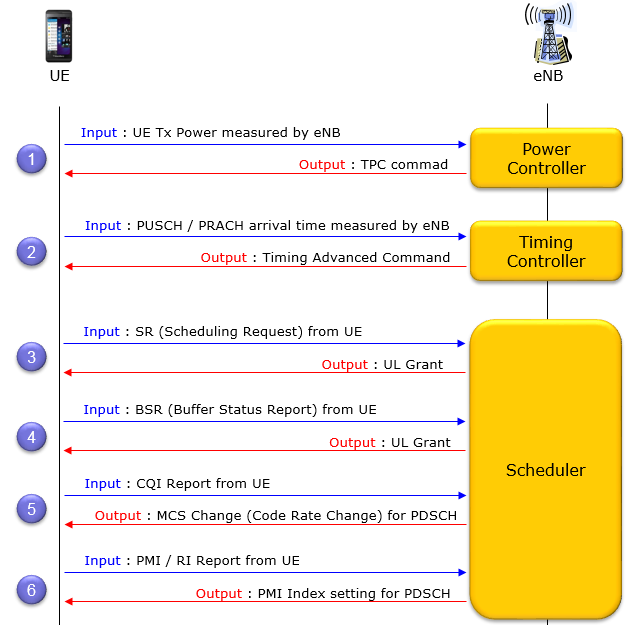|
|
||
|
UE feedback and Scheduling / ControlIn LTE (actually in most of cellular communication), Network (eNB) and UE are interacting with each other in a kind of Master and Slave. It am not talking about such a clearly defined Master and Slave in IP communication. I am using the term Master / Slave in the sense that eNB (Network) decide on almost everything and UE just follows what the network tells them to do. However, the Master (eNB) in LTE is not such a heartless dictator who doesn't listen to others at all. The master's eary is always open to the slaves and they are constantly observing the slave to maintain the communication in best possible status with maximum efficiency of resource allocation. Then you would ask what eNB is listening from UE and what eNB is observing ? Followings are a list of those things poping up in my mind. The number shown here does not have any special meaning .. They are just the numbers for my explanation. You can assume that all of these things are running at the same time.
It would take a couple of separate pages for each topics. So I would not put down any detailed explanation here about these procedure. I will write down a few lines of comments here and give you the link that will lead you to the full details. (1) TPC : Power ControlThis is the process by which the open loop power control performs. Basic mechanism is that eNB measures the uplink power (UE Tx power) and transmit the appropriate TPC commands until it gets the desired UE power. See Power Control page for the details. (2) Timing Control : Timing AdvanceThis is the mechanism by which eNB adjust UE transmission power by observing the arrival time of PRACH signal or PUSCH and sending proper adjustment command. In case where eNB observes PRACH signal, it sends the adjustment command via RAR(RACH response) and in case where eNB observes PUSCH, it sends the adjusment command vis Timing Advanced MAC CE. See following pages for further details. (3) SR (Scheduling Request)UE cannot transmit PUSCH (UL Data) on its own. It always should get approval (UL Grant) from eNB. What if eNB does not provide UL Grant when UE need to get ? In this case, UE can request eNB to provide UL Grant by sending SR (Scheduling Request). See Scheduling Request page for full details. (4) BSR (Buffer Status Request)SR is a physical layer message to request one time UL Grant. However, if UE needs large amount of UL Grants to send big chunk of data, it can send a MAC layer command called BSR and eNB would send multiple UL Grants in sequence enough for UE to transmit the data. See BSR page for the details. (5) CQI (Channel Quality Indicator)When radio channel quality gets poor and UE frequently fails to decode the downlink data (PDSCH), UE can notify the eNB to send data in more robust format (i.e, lower code rate). CQI is a kind of command from UE to eNB to adjust the code rate of the downlink data, then eNB can adjust the code rate by changing MCS. See CQI page for the details. (6) PMI(Precoding Matrix Information)/RI (Rank Indicator)These two report (indicators) are used only for MIMO configuration. You can think of these of an indicator representing the quality of MIMO channel configuration. When these report are received by eNB, eNB changes MIMO channel configuration (Precoding Matrix) dynamically to optimize the formation of downlink data so that UE can easily decode it. See Closed Loop MIMO for the details.
|
||
